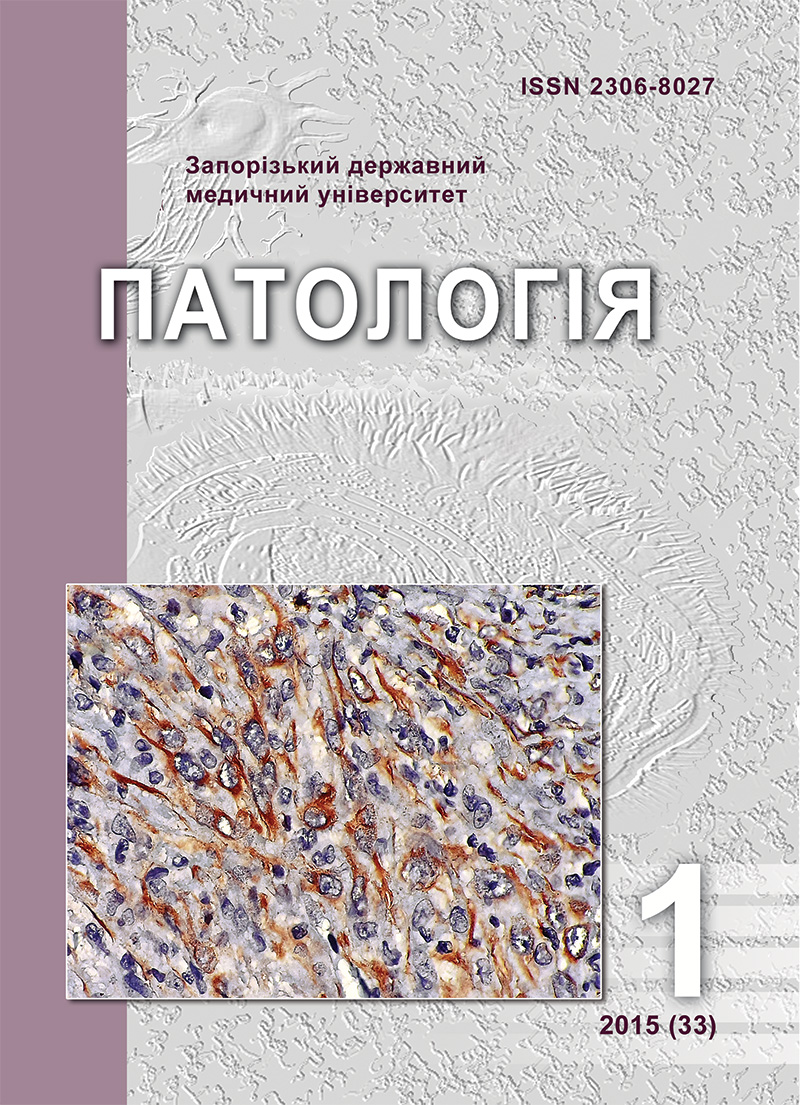Dynamics of pathological changes of myocardial structures of rats under administration of doxorubicin
DOI:
https://doi.org/10.14739/2310-1237.2015.1.42816Keywords:
Doxorubicin, Myocardium, RatsAbstract
Due to the high cardiotoxicity of doxorubicin it is used to study pathogenesis of heart failure.
Aim. In order to study the dynamics of pathological changes of the heart in the experiment, ECG, pathological and histopathological changes in the myocardium were investigated in 60 rats with doxorubicin cardiomyopathy and 60 rats in the control group.
Methods and results. We found that irreversible myocardial damage, established by us in the dynamics, namely destructive and degenerative changes of cardiomyocytes with the loss of their special characteristics, as a result of doxorubicin effect are not only local, but also diffuse, markers of which are the violation of the functional aspect of automaticity, conduction of the heart and rapidly progressive heart failure.
References
Chekman, I. S., Gorchakova, N. O., Nizhenkivs'ka, I. V., Nagorna, O. O., Mincer, V. O., Trofimova, T. S., & Vygivs'ka, O. A. (2003) Vplyv rubomitsynu hidrokhlorydu na pokaznyky hemodynamiky u kroliv [Effect of rubomicin hydrochloride on hemodynamic parameters in rabbits]. Medicine, 5–6, 88–89. [in Ukrainian].
Stefanov, A. V. (Ed) (2002) Doklinicheskie issledovaniya lekarstvennykh sredstv [Preclinical studies of drugs]. Kyiv: Avicenna. [in Ukrainian].
Kalinkina, N. V. (2000) Povrezhdeniya serdca antraciklinami: chastota i faktory riska [Damage to the heart anthracyclines: incidence and risk factors]. Ukrainskyi medychnyi chasopys, 16(2), 25–29. [in Ukrainian].
Korzhevskij, D. E`., & Gilyarov, A. V. (2010) Osnovy gistologicheskoj tekhniki [Fundamentals of histological techniques]. Saint Petersburg: SpecLit. [in Russian].
Matyash, M. G., Kravchuk, T. L., Vysotskaya, V. V., Chernov, V. I., Goldberg, V. E. (2008) Inducirovannaya antraciklinami kardiotoksichnost': mekhanizmy razvitiya i klinicheskie proyavleniya [Anthracycline-induced cardiotoxicity: mechanisms of development and clinical manifestations]. Sibirskij onkologicheskij zhurnal, 30(6), 66–75. [in Russian].
Lapach, S. N., Chubenko, A. V., Babich, P. N. (2001) Statisticheskie metody v mediko-biologicheskikh issledovaniyakh s ispol'zovaniem Excel [Statistical methods in biomedical research using Excel]. Kyiv: Morion. [in Ukrainian].
Rodynskyi, O. G., & Kozlova, Yu. V. (2014) Povedinkovi rozlady u shchuriv na foni eksperymentalnoi khronichnoi miokardialnoi dysfunktsii [Behavioral disorders in rats on a background of chronic experimental myocardial dysfunction]. Medychni perspektyvy, 19(3), 10–14. [in Ukrainian].
Semenova, A. I. (2009) Kardio- i nejrotoksichnost' protivoopukholevykh preparatov (patogenez, klinika, profilaktika, lechenie) [Cardio- and neurotoxicity of anticancer drugs (pathogenesis, clinical, prevention, treatment)]. Prakticheskaya onkologiya, 10(3), 168–176. [in Russian].
Cove-Smith, L., Woodhouse, N., Hargreaves, A., Kirk, J., Smith, S., Price, S. A., et al. (2014) An integrated characterization of serological, pathological, and functional events in doxorubicin-induced cardiotoxicity. Toxicol Sci., 140(1), 3–15. doi: 10.1093/toxsci/kfu057.
Kumar, S. N., Konorev, E. A., Aggarwal, D. & Kalyanaraman, B. (2011) Analysis of proteome changes in doxorubicin-treated adult rat cardiomyocyte. J. Proteomics, 74 (5), 683–697. doi: 10.1016/j.jprot.2011.02.013.
Downloads
How to Cite
Issue
Section
License
Authors who publish with this journal agree to the following terms:
Authors retain copyright and grant the journal right of first publication with the work simultaneously licensed under a Creative Commons Attribution License that allows others to share the work with an acknowledgement of the work's authorship and initial publication in this journal.

Authors are able to enter into separate, additional contractual arrangements for the non-exclusive distribution of the journal's published version of the work (e.g., post it to an institutional repository or publish it in a book), with an acknowledgement of its initial publication in this journal.
Authors are permitted and encouraged to post their work online (e.g., in institutional repositories or on their website) prior to and during the submission process, as it can lead to productive exchanges, as well as earlier and greater citation of published work (SeeThe Effect of Open Access).

